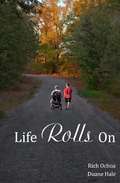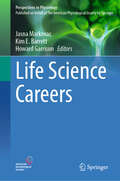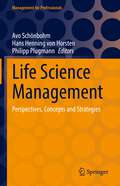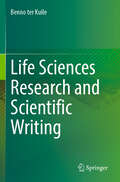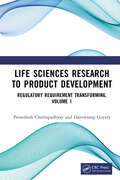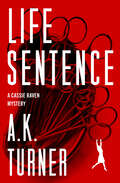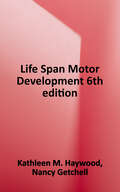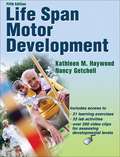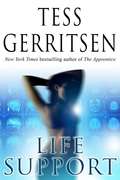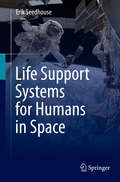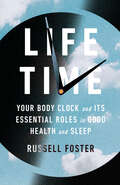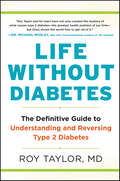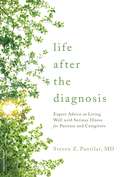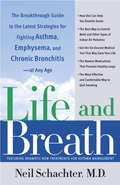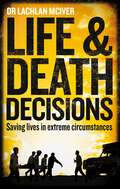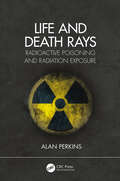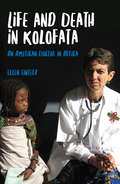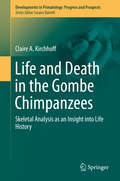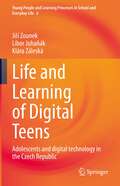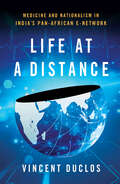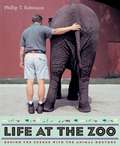- Table View
- List View
Life Rolls On (2nd Edition)
by Rich Ochoa Duane HaleWhen he was four years old, doctors told Duane Hale's parents that their son had Spinal Muscular Atrophy and that he wouldn't live past his teens. That was forty-two years ago and he has now outlived some of those doctors. What happens to a rambunctious little boy whose disease turns him into a man who can't move? How does such a man graduate high school as Student of the Year, work twenty years for the police department, buy a house, get married, father and raise a son?This is the story of a man and the strength he derives from his family and his community. Even as the disease paralyzes more of his body every day his spirit stays strong and Life Rolls On.
Life Science Careers (Perspectives in Physiology)
by Jasna Markovac Kim E. Barrett Howard GarrisonThis book is written for the many Life Science PhD students who may pursue careers outside of academic research. Even though the biggest portion of students will ultimately pursue other paths, university education trains them mostly for the academic track. Students often miss information, resources, contacts, or opportunities to explore other options. In response, the editors assembled a diverse group of authors from all fields related to Life Science research. The chapters offer a peek behind the curtain of each industry and offer guidance on how to move towards such roles. Through a high level of uniformity, students will get a plethora of career stories, each providing job opportunities, job descriptions, resources, and useful contact information. The purpose of this volume is to illustrate the many excellent opportunities that are available to life science PhDs, which will still allow them to make significant contributions to science.
Life Science Management: Perspectives, Concepts and Strategies (Management for Professionals)
by Philipp Plugmann Avo Schönbohm Hans Henning von HorstenThe COVID-19 pandemic has reminded us of how important the life science industry is, and compels us to find efficient management methods specific to the industry. Pharmaceuticals, drug and vaccine development labs, R&D labs, medical instrumentation, and tech companies, hygiene supply companies, medical distribution chains, all form an integral part of this industry. At the interface of scientific research, technology, innovation and management and embedded in regulatory and legal frameworks, life science management is still an under-researched field of practice and science. This edited volume addresses this research gap and offers a wide range of practical and theoretical contributions that provide insights into one of the most exciting industries. The book is primarily directed at practitioners and decision makers in the life science industry. Students and professionals of life science management at all levels as well as policy makers will find valuable insights and inspiration for their daily work and career development.
Life Sciences Research and Scientific Writing
by Benno ter KuileScientific writing is a trade that can and must be learned and not a form of art that is limited to the talented. The real constraint for writing a good scientific article is most of the time not the usage of the English language, but the conversion of outcomes of a set of experiments into a coherent and convincing scientific story. This book is designed to guide junior scientists in the Life Sciences writing their thesis and first manuscripts, along this uphill struggle. All aspects of building up and publishing a forceful scientific narrative are covered, from designing experiments to dealing with the reviewers’ comments. This book takes you step by step through the process of writing a paper. It starts by discussing how to collect and organize data and make an outline. The actual writing starts with the Results section, as this is the heart of any research paper. The Discussion interprets your data in the framework of the existing literature and explains the novel insights you obtained. The Introduction is written to pose the questions that are answered in the Discussion and give the necessary background information. It is written after the Results and Discussion to make sure it is a perfect match. The M&M is the easiest to write. A good abstract is essential for attracting readers. How to write that is described in detail. The title is the last piece of the puzzle. The book contains many practical examples that explain the general principles of good writing. These examples are all from the Life Sciences and so are the anecdotes that illustrate the concepts, making the information directly applicable. All kinds of tips and suggestions are provided for improving readability and accessibility of your manuscript, thus making it easier acceptable. In addition, background information on the basics of science is supplied that helps to avoid common mistakes that cause rejection of manuscripts that report on otherwise good science.
Life Sciences Research to Product Development: Regulatory Requirement Transforming, Volume 1
by Pronobesh Chattopadhyay Danswrang GoyaryThe present volume, Life Sciences Research to Product Development: Regulatory Requirement Transforming, Volume 1, discusses the procedures of drug approval and regulatory requirements that must be met according to the United States Food and Drug Administration (US FDA), the European Medical Agency (EMA), and the Central Drug Standard Control Organization (CDSCO). Many researchers either abandon their work in the middle of the process or find it difficult to follow the rules. Therefore, it is not surprising that any biological researcher associated with drug development should have a thorough understanding of regulatory requirements. This volume incorporates all the requisite regulatory norms and provides the latest information on the mandated regulation of herbal medicines.The book covers other obligatory regulatory requirements such as: The legal method and practice of herbal drug products, the roles of Ayurvedic medicines, and the process to obtain regulatory approval. Drug molecules not included in Department of Ayurveda, Yoga, Naturopathy, Unani, Siddha, and homeopathy (AYUSH) but referred to as phytopharmaceuticals are also considered new drugs. The boundary line between food and herbal pharmaceuticals is discussed, as well as pre-clinical toxicity testing, clinical trials, and stability studies in accordance with the rules. The chapter on regulatory implications for the approval process in this book will be the most useful resource for researchers and students, particularly those with backgrounds in pharma, forensic medicine, or regulatory affairs, or those who aspire to succeed in drug research. Additionally, the information contained in this volume of the book could be of great interest to researchers working in the herbal drug industry.
Life Sentence
by Andrew NeidermanMaster of suspense Andrew Neiderman spins a spine-tingling tale about an aging experiment that goes horribly awry, and the lengths to which people will go to stop the clock In the Intensive Care Unit of the Oakland Clinic, a terminally ill patient vanishes. An elderly patient suddenly flat-lines . . . and that&’s just the beginning. Today, Ceil Morris had a visit from her son. Except that Bradley Morris, a convicted murderer, was killed in prison six months ago. So who is the man who shows up on Ceil&’s doorstep claiming to be her only child—a man decades older than she? Soon homicide cops Palmer Dorian and Tucker Browning find themselves investigating a shadowy organization and a scientist known for his revolutionary work on aging. But their search for answers brings them face-to-face with a seemingly unstoppable evil from which even they may not escape.
Life Sentence (The Cassie Raven Mysteries)
by A.K. TurnerIn this gritty crime novel by the author of Body Language, a London morgue assistant investigates a family secret that started with murder. &“What a wonderful creation is Cassie Raven!&” —James Oswald, author of Natural Causes Mortuary technician Cassie Raven grew up believing that a drunk driver killed her parents when she was just four years old. The tragedy molded her, giving her an affinity for the dead and pushing her into the field of forensic science. Now twenty-five, she has discovered it was all a lie. Her father went to prison for her mother&’s murder—and now he&’s free and adamant that he&’s innocent. Her head full of questions, Cassie begins searching for answers about her mother&’s death. With help from her friend DS Phyllida Flyte, Cassie expects an open-and-shut case. What they find is that the truth is far more complicated. And someone will do anything to keep it secret . . .Praise for Body Language &“Spellbinding storytelling.&” —Val McDermid, international bestselling author &“Cassie Raven is a blast of fresh air, striding on to the crime scene like a punk superstar.&” —Sarah Hilary, author of Someone Else&’s Skin &“A first-rate crime novel. . . . I loved it.&” —Elly Griffiths, author of the Ruth Galloway seriesPerfect for fans of Tess Gerritsen, Patricia Cornwell, and Kathy Reichs
Life Span Motor Development
by Nancy Getchell Kathleen M. HaywoodThis book uses the model of constraints in discussing reasons for changes in movement throughout the life span, Focusing on assessment more heavily than previous editions, this updated edition encourages students to examine how the interactions of the individual, environment, and task bring about changes in a person''s movements. The principles of motor development are presented in an accessible manner so that even readers with minimal movement science background will comprehend the material. A key component of the sixth edition is an improved web study guide featuring revised lab activities and better functionality. New to this edition, lab activity record sheets and questions are available as fillable documents so that students can complete and submit them electronically, resulting in increased efficiency and reduced paperwork for instructors. In several labs, guided assessments teach students to observe video and categorize movements accurately. These assessments cue students to look at particular parts of the movement and guide students through questions, answers, and feedback. Then students are provided opportunities for unguided assessments via video clips or live observation, putting into practice what they have learned in the guided assessments.
Life Span Motor Development (5th edition)
by Kathleen Haywood Nancy GetchellAfter introducing Newell's constraints model, Haywood (University of Missouri) and Getchell (University of Delaware) examine physical growth and aging of the body as a whole and of specific body system, describe changing motor patterns over the life span, and explore the role of perception, social constraints, and exercise. The fifth edition moves the chapter on the basic principles of motion and stability from the website to the book. Annotation ©2009 Book News, Inc. , Portland, OR (booknews. com)
Life Support
by Tess GerritsenFrom New York Times bestselling author Tess Gerritsen, a terrifying novel of deadly proportions as an ER doctor tries to determine the cause and cure of a fatal and mysterious virus before it becomes an epidemic.The quiet overnight shift at Springer Hospital ER suits Dr. Toby Harper just fine—until she admits a man in critical condition from a possible viral infection of the brain. The delirious man barely responds to treatment—and then disappears without a trace. Before Toby can find him, a second case occurs, revealing a terrifying fact: the virus can only be spread through direct tissue exchange. Following a trail of death that winds from a pregnant sixteen-year-old prostitute to her own home, Toby discovers the unthinkable: the epidemic didn't just happen—someone let it loose....
Life Support (Grace Medical #3)
by Candace CalvertNurse Lauren Barclay put her life on hold to keep a watchful eye on her troubled sister. It's why she's back in Houston. But that means confronting the brooding physician assistant who caused painful turmoil in her family--and left Lauren with memories her heart can't forget. Pa and single parent Elijah Landry is no stranger to stormy relationships, including one with his father, who is threatening him with a restraining order. It won't stop Eli from protecting his disabled brother--or from making peace with Lauren. He wants that and so much more. But as Lauren and Eli draw closer, a powerful hurricane roars toward Houston. Survival instincts take priority and everything changes. Can hope weather the storm? CANDACE CALVERT is a former ER nurse and author of the Mercy Hospital and Grace Medical series. Her medical dramas offer readers a chance to "scrub in" on the exciting world of emergency medicine. Wife, mother, and very proud grandmother, Candace makes her home in northern California. Please visit her website at www.candacecalvert.com.
Life Support Systems for Humans in Space
by Erik SeedhouseLife support systems are an integral part of crewed spacecraft designs and habitation systems. This textbook introduces the LSS capabilities that sustain humans who live and work in space, and it is written at a level appropriate for both undergraduate and postgraduate students.The book begins with the basics of space physiology before detailing the features that make up different kinds of life support systems. It includes concise descriptions of how atmospheric pressure is monitored, how oxygen levels are maintained, how waste management is achieved and how water is recycled, and also describes the processes of fire detection and suppression. Several chapters are devoted to chronicling the evolution of life support systems through the decades. Each chapter includes a list of learning objectives, summary sections and review questions. Additionally, various analogs for spaceflight life support systems are examined, including nuclear submarines and our natural life support system here on Earth! Overall, this book serves as an approachable primer for any student seeking to understand the intricacies of spacecraft life support systems.
Life Time: Your Body Clock and Its Essential Roles in Good Health and Sleep
by Russell FosterA guide to using the science of the body clock to create the optimum personal routine. Sleep better, work better, feel better. &“Full of surprising and useful facts. . . . Unlike many science books with similar subtitles, it really might &‘revolutionise&’ your life.&”—James McConnachie, The Times (London) &“A comprehensive manifesto for living in harmony with our body clocks, penned by someone who has devoted his career to studying them.&”―Financial Times The routines of our modern lives—home working, night shifts, technology—are playing havoc with our body clocks, sleep patterns, and health. Packed with cutting edge science, this book by award-winning scientist Russell Foster takes the reader on a journey through our days and nights, and explains how we can get back into rhythm and live healthier, sharper lives. In the past few decades, there has been an explosion of discoveries around the science of the body clock and our twenty-four-hour biological cycles. Sleep and daily rhythms emerge from our genetics, physiology, behavior, and the environment. Like most of our behaviors, they are not fixed. These rhythms are modified by our actions, how we interact with the environment, and how we progress from birth to old age. Cutting through long-standing myths, Foster empowers readers by providing concrete information and guidance that can be used to understand what makes the body clock &“tick.&”
Life Without Diabetes: The Definitive Guide to Understanding and Reversing Type 2 Diabetes
by Roy TaylorTHE US EDITION OF THE INTERNATIONAL BESTSELLER A momentous medical breakthrough —a scientifically proven program for managing and reversing Type 2 Diabetes at any stage of health.The fastest growing disease in the world, Type 2 diabetes has long been regarded as an incurable, lifelong condition that becomes progressively worse over time, resulting in pain, loss of vision, amputation, and even premature death. But there is hope. For more than four decades, Dr. Roy Taylor has been studying the causes of diabetes. In 2017, he had a breakthrough: he found scientific proof that Type 2 diabetes is not only reversible, but that anyone following a simple regimen can prevent and cure it. Dr. Taylor’s research shows that Type 2 diabetes is caused by too much fat in the liver and pancreas, which interferes with both organs’ normal functioning. By losing less than 1 gram of fat, the liver and organ can begin to perform as they were designed to once again—thus beginning the reversal process. The most efficient way to shed fat from the liver and pancreas is to lose weight as quickly as possible. Life Without Diabetes makes it easy for people to cut back on their daily calorie intake and avoid the two big problems of dieting—hunger and choice—and lose up to 35 pounds in just eight weeks. Thanks to Dr. Taylor, we can now fundamentally change how we treat and prevent this debilitating and all-too-common disease forever.
Life Without Me
by Anna LegatA darkly and brilliantly funny look at what being a fly on the wall is really like, Life Without Me is Anna Legat’s debut novel.Georgie Ibsen is a successful, cynical, fortysomething hotshot lawyer. She runs her life, professional and personal, with precision and clear purpose. She’s just made a breakthrough in a crucial case, her family is growing more independent … things couldn’t be better.Until it all comes to a screeching halt when she’s involved in a hit-and-run and ends up in a coma.Somehow, in her comatose state, Georgie is given unique glimpses into the lives of her nearest and dearest, their most intimate secrets: her boring husband’s intense involvement with a colleague; her son’s lovelorn yearning for his mother’s nurse; her fifteen-year-old daughter’s bad boy boyfriend, who just might be linked to the criminal mastermind involved in her last big case…Throw in a neurotic actress sister, a senile mother with a traumatic past, and a smug subordinate barrister who’s out to ruin her case in her absence…oh, and a sex-god lawyer extraordinaire who’s a deeply troubled soul with a penchant for some unsavoury practices…although Georgie is out of action, life certainly isn’t boring without her!
Life after the Diagnosis: Expert Advice on Living Well with Serious Illness for Patients and Caregivers
by Steven PantilatFor a time of growing concern about living well with serious illness and getting the best possible end-of-life care, Life After the Diagnosis delivers a compassionate and sensitive guide for patients, families, and caregivers.In Life After the Diagnosis, Dr. Steven Z. Pantilat, a renowned international expert in palliative care, shares innovative approaches for dealing with serious illness, outlines the steps that patients should take, and demystifies the medical system. He makes sense of what doctors say, what they actually mean, and how to get the best information to help make the best medical decisions. Dr. Pantilat covers everything from the first steps after the diagnosis and finding the right caregiving and support, to planning your future so your loved ones don't have to. He offers advice on how to tackle the most difficult treatment decisions and discussions and shows readers how to choose treatments that help more than they hurt, stay consistent with their values and personal goals, and live as well as possible for as long as possible.
Life and Breath
by Neil SchachterThe fourth leading cause of death in the United States, COPD, or chronic obstructive pulmonary disease, affects an estimated 35 million Americans. Yet only half are aware that they are seriously ill. Life and Breath, by Dr. Neil Schachter, is the first book that alerts people to their risks for COPD and explains the steps they need to take to prevent the development of this debilitating and often fatal lung disease. Life and Breathbegins witha quick quiz to rate your risk for COPD. It explains the steps of a complete pulmonary work-up and teaches you about the painless, inexpensive six-second test that can save your life. We all know that diet, exercise, and environmental changes can reduce the risk of heart disease and some types of cancer. Now, for the first time,Life and Breathprovides the medical and lifestyle steps that can prevent, treat, and sometimes reverse the signs and symptoms of chronic lung disease. Dr. Schachter discusses the role of antioxidants in treating asthma and chronic bronchitis, explains why indoor exercise is better if you have irritable airways, and provides a supportive, simple, and successful plan to quit smoking. Life and Breathtakes you on a tour of your own home, pointing out sources of irritants and allergens that can cause pulmonary problems. Dr. Schachter explains how to improve indoor air quality to protect your lungs at any age, on the job, in your home, and on the road. If you are one of the 15 million Americans with asthma, or one of the 94 million current or former smokers in this country, Life and Breathis the one book you need to stay alive and well. From the Hardcover edition.
Life and Death Decisions: Fighting to save lives from disaster, disease and destruction
by Dr Lachlan McIver***'Just brilliant. The book of the decade.' - Professor Tim Flannery, Former Australian of the Year 'An honest, powerful and riveting book that demonstrates Lachlan's courage in the face of the hardest of circumstances.' - Levison Wood, Award-winning author, explorer and photographer'Wow. A hugely important and enjoyable book that will restore your faith in humanity and what is possible... Deeply moving and at times tragic but never losing a sense of optimism or hope.' - Sir Jeremy Farrar, Director of the Wellcome TrustLachlan was sixteen when he found his father dead on the side of a dirt road in North Queensland, Australia. He had suffered a sudden heart attack and died alone. It was this tragedy that motivated Lachlan to train as a doctor specialising in providing medical care for people living in remote, resource-deprived locations. Lachlan's work with the World Health Organization and Médecins Sans Frontières has taken him to some of the world's most extreme environments, from the sinking islands of the Pacific to epidemics and war zones in the Middle East and sub-Saharan Africa. In this no-holds-barred memoir, Lachlan recounts his experiences treating patients ravaged by tropical diseases, managing war wounds with drug-resistant infections, delivering babies by the light of a head torch, dealing with the devastating effects of climate change and narrowly avoiding being kidnapped by militia in the Democratic Republic of the Congo. Tackling such impossible problems day in and day out inevitably takes a personal toll. Lachlan is ultimately forced to face his own battles with depression, alcohol abuse and bankruptcy.Life and Death Decisions is a deeply human look at the personal cost of our broken global health system and a vital call to action.
Life and Death Rays: Radioactive Poisoning and Radiation Exposure
by Alan PerkinsThis unique book provides an accessible introduction to both the scientific background and the key people involved in the discovery and use of radiation and radioactivity. It begins by providing a short history of radiation exposures and radiation poisoning; from the early inappropriate use of X-rays and radium cures through the misadventures of the Manhattan Project and the Chernobyl disaster, to the high-profile and deliberate poisoning of Alexander Litvinenko in London with polonium-210, which gave rise to worldwide media attention. The chapters provide a catalogue of deliberate criminal acts, unfortunate accidents, and inadvertent radiation exposures, exploring well-known events in detail, as well as some not so well-known occurrences. It works through the topics by focusing on human stories and events and their biological impact. In addition, it covers descriptions of the beneficial uses of radiation and radioactivity. This book can be enjoyed by any reader with a general interest in science, as well as by students and professionals within the scientific and medical communities. Key features Authored by a subject area specialist who has worked in both clinical practice and academia and was involved with the national media following incidents of national and international importance Provides a unique human perspective into well-known and some lesser known events and a concise history of the discovery of radiation and the events that followed Adds scientific and medical background to a subject of high media interest
Life and Death in Kolofata: An American Doctor in Africa
by Ellen EinterzWhen Dr. Ellen Einterz first arrives in the town of Kolofata in Cameroon, the situation is dire: patients are exploited by healthcare workers, unsterilized needles are reused, and only the wealthy can afford care. In Life and Death in Kolofata: An American Doctor in Africa, Einterz tells her remarkable story of delivering healthcare for 24 years in one of the poorest countries in the world, revealing both touching stories of those she is able to help and the terrible suffering of people born in extreme poverty. In one case, a 6-year-old burn victim suffers after an oil tanker tips and catches fire; in another story, Dr. Einterz delivers a child in the front yard of her home. In addition to struggling to cure diseases and injuries and combat malnutrition, Einterz faced another kind of danger: the terrorist organization Boko Haram had successively kidnapped foreigners from Cameroon, and they had set their sights on the American in Kolofata. It would only be a matter of time before they would come for her. Tragic, heartwarming, and at times even humorous, Life and Death in Kolofata illustrates daily life for the people of Cameroon and their doctor, documenting both the incredible human suffering in the world and the difference that can be made by those willing to help.
Life and Death in Rikers Island
by Homer VentersShining a light on the deadly health consequences of incarceration.Finalist in the PROSE Award for Best Book in Anthropology, Criminology, and Sociology by the Association of American PublishersKalief Browder was 16 when he was arrested in the Bronx for allegedly stealing a backpack. Unable to raise bail and unwilling to plead guilty to a crime he didn't commit, Browder spent three years in New York's infamous Rikers Island jail—two in solitary confinement—while awaiting trial. After his case was dismissed in 2013, Browder returned to his family, haunted by his ordeal. Suffering through the lonely hell of solitary, Browder had been violently attacked by fellow prisoners and corrections officers throughout his incarceration. Consumed with depression, Browder committed suicide in 2015. He was just 22 years old. In Life and Death in Rikers Island, Homer Venters, the former chief medical officer for New York City's jails, explains the profound health risks associated with incarceration. From neglect and sexual abuse to blocked access to care and exposure to brutality, Venters details how jails are designed and run to create new health risks for prisoners—all while forcing doctors and nurses into complicity or silence. Pairing prisoner experiences with cutting-edge research into prison risk, Venters reveals the disproportionate extent to which the health risks of jail are meted out to those with behavioral health problems and people of color. He also presents compelling data on alternative strategies that can reduce health risks. This revelatory and groundbreaking book concludes with the author's analysis of the case for closing Rikers Island jails and his advice on how to do it for the good of the incarcerated.
Life and Death in the Gombe Chimpanzees: Skeletal Analysis as an Insight into Life History (Developments in Primatology: Progress and Prospects)
by Claire A. KirchhoffThis book addresses how skeletons can inform us about behavior by describing skeletal lesions in the Gombe chimpanzees, relating them to known life histories whenever possible, and analyzing demographic patterns in the sample. This is of particular interest to both primatologists and skeletal analysts who have benefited from published data on a smaller, earlier skeletal sample from Gombe. The Gombe skeletal collection is the largest collection of wild chimpanzees with known life histories in existence, and this work significantly expands the skeletal sample from this long-term research site (49 chimpanzees). The book explores topics of general interest to skeletal analysts such as demographic patterns, which injuries leave signs on the skeleton, and rates of healing, and discusses both qualitative and quantitative analysis of the patterning of lesions. The book presents the data in a narrative style similar to that employed in Dr. Goodall’s seminal work The Chimpanzees of Gombe. Readers already familiar with the Gombe chimpanzees are likely to appreciate summaries of life events correlated to observable skeletal features. The book is especially relevant at this time to remind primate conservationists of the importance of the isolated chimpanzee population at Gombe National Park as well as the availability of the skeletons for study, both within the park itself as well as at the University of Minnesota.
Life and Learning of Digital Teens: Adolescents and digital technology in the Czech Republic (Young People and Learning Processes in School and Everyday Life #6)
by Jiří Zounek Libor Juhaňák Klára ZáleskáThis book describes and explains how digital technologies enter adolescents’ everyday life and learning in different contexts and environments. The book is based on research conducted in recent years in the Czech Republic, the results of which are set within a broad theoretical and international framework.The authors consider the theoretical and methodological anchoring of the topic, describing various approaches in an effort to comprehensively describe and understand the learning process of today’s pupils. They focus on ways to explore learning in the digital era, domestication of digital technology in families, and parents' approaches to digital technology. Attention is paid to adolescents’ competences and autonomy in the use of digital technologies, as well as their views on technology in their lives and learning. The authors summarize the most important results of the research, but also consider the options of empirical research and their own experience with the research of such a complex concept.
Life at a Distance: Medicine and Nationalism in India's Pan-African e-Network (Expertise: Cultures and Technologies of Knowledge)
by Vincent DuclosIn Life at a Distance, Vincent Duclos recounts the story of the Pan-African e-Network. Branded as "India's gift to the world," and as a "shining example of South-South cooperation," the Pan-African e-Network was an exceptionally ambitious project. Between 2009 and 2017 the network used satellite technology to connect hospitals across Africa with hospitals in India, providing medical education and delivering health care for patients at a distance. Duclos shows how, by accelerating the flow of expertise across continents, the network also created connected enclaves, at once commercial, infrastructural, and medical. Life at a Distance is the story of a project that, Duclos suggests, acted as a medium for speculation about the future—about medical markets, the nation, South-South relations, and a new world order beyond Western-centric scripts.
Life at the Zoo: Behind the Scenes with the Animal Doctors
by Phillip RobinsonPlease Do Not Annoy, torment, pester, plague, molest, worry, badger, harry, persecute, irk, bullyrag, vex, disquiet, grate, beset, bother, tease, nettle, tantalize or ruffle the Animals.—sign at zooSince the early days of traveling menageries and staged attractions that included animal acts, balloon ascents, and pyrotechnic displays, zoos have come a long way. The Ménagerie du Jardin des Plantes in Paris, founded in 1793, didn't offer its great apes lessons in parenting or perform dental surgery on leopards. Certainly the introduction of veterinary care in the nineteenth century—and its gradual integration into the twentieth—has had much to do with this. Today, we expect more of zoos as animal welfare concerns have escalated along with steady advances in science, medicine, and technology. Life at the Zoo is an eminent zoo veterinarian's personal account of the challenges presented by the evolution of zoos and the expectations of their visitors. Based on fifteen years of work at the world-famous San Diego Zoo, this charming book reveals the hazards and rewards of running a modern zoo. Zoos exist outside of the "natural" order in which the worlds of humans and myriad exotic animals would rarely, if ever, collide. But this unlikely encounter is precisely why today's zoos remain the sites of much humor, confusion, and, occasionally, danger. This book abounds with insights on wildlife (foulmouthed parrots, gum-chewing chimps, stinky flamingoes), human behavior (the fierce competition for zookeeper jobs, the well-worn shtick of tour guides), and the casualties—both animal and human—of ignorance and carelessness. Phillip Robinson shows how animal exhibits are developed and how illnesses are detected and describes the perils of working around dangerous creatures. From escaping the affections of a leopard that thought he was a lap cat to training a gorilla to hold her newborn baby gently (instead of scrubbing the floor with it) and from operating on an anesthetized elephant ("I had the insecure sensation of working under a large dump truck with a wobbly support jack") to figuring out why a zoo's polar bears were turning green in color, Life at the Zoo tells irresistible stories about zoo animals and zoo people.
